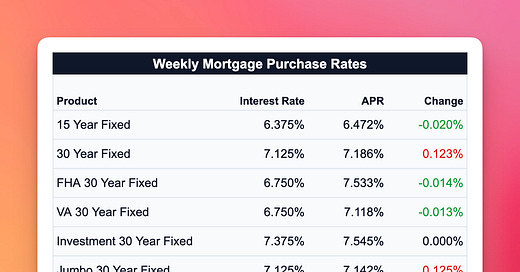Elections & Rates - Nov 4 - Weekly Mortgage Update
Despite a weak jobs report (only 12,000 jobs added vs 113,000 expected), markets ignored traditional patterns as bond yields climbed higher, driven by inflation concerns and pre-election positioning.
Request a Quote
A complete workup of your payment and closing costs on any home purchase or existing mortgage refinance. (no credit checks, Texas-only)
⭐️ Check This Out
Apparently, a hint of lower mortgage rates was enough to boost September's pending home sales by 7.4%.
Job openings are disappearing faster than avocado 🥑 at a brunch party, signaling the labor market might finally be chilling out.
In 2025, real estate pros face elections, expensive insurance, and AI magic; because nothing says “stability” like unpredictable tech and politics.
With more listings but still-cautious buyers, the housing market's like an open house where everyone just came for the snacks.
📊 Market Update
Remember when markets made sense? When good news was good news and bad news was bad news? Well, this week decided to throw that playbook right out the window, giving us a masterclass in why context is everything in financial markets.
If you've been paying attention, you might have noticed something peculiar: we got what should have been a monumentally weak jobs report (just 12,000 jobs added versus an expected 113,000), and yet... bonds sold off. Yes, you read that right. The kind of report that traditionally sends yields plummeting instead had them climbing higher.
So, what gives?
🤔 When Numbers Lie
Let's start with the headline that should have been market-moving: October's jobs report showed just 12,000 new jobs. In any normal month, this would have been a five-alarm fire for the economy. But here's the thing – this wasn't a normal month.
Between hurricanes disrupting employment and various labor strikes, the numbers came with more asterisks than a pharmaceutical warning label. The Bureau of Labor Statistics (BLS) even included a special note about hurricane impacts, which is their way of saying "Hey, don't take this too seriously."
While the headline number was weak, the unemployment rate held steady at 4.1% – exactly where economists expected it to be. Put simply, the job market's foundation remains solid, even if the monthly addition of jobs took a weather-related vacation.
Remember: The unemployment rate isn't affected by temporary disruptions the same way payroll numbers are. It's like checking your bank account balance (unemployment rate) versus looking at a single month's transactions (payroll numbers).
The Inflation Plot Twist
TLDR:
ISM Prices Paid hit yearly highs
Markets are spooked by inflation risks
Echoes of early 2024's inflation surge are haunting traders
Just when you thought you had it figured out, enter stage left: The ISM Prices Paid index jumped to 54.8 versus an expected 48.5, the highest level of the year. In other words, while everyone was focused on jobs, inflation raised its hand with an uncomfortable "still here!" reminder.
This surge in prices paid by manufacturers isn't just another data point – it's stirring up some uncomfortable memories. Cast your mind back to early 2024, when we thought inflation was firmly in the rearview mirror, only to watch it make an unwelcome comeback. Markets have a funny way of remembering these things, and right now, they're showing signs of PTSD – Post-Transitory Stress Disorder.
What makes this particularly spicy is the timing.
The Fed has spent months carefully crafting their "disinflation" narrative, and markets had largely bought in. But here's the thing about inflation – it has a habit of popping up just when everyone's getting comfortable.
The jump in ISM Prices Paid suggests that cost pressures at the manufacturing level might be building again, and historically, these tend to flow through to broader price measures.
Adding another layer of complexity, we're seeing similar pressure signals in other corners of the economy. Energy prices have been quietly creeping higher, wage growth remains sticky, and now manufacturing costs are joining the party.
It's like watching a sequel nobody asked for: "Inflation: The Inflation Strikes Back. And somewhere in the Eccles Building, you can almost hear Jerome Powell breathing heavily into his microphone: "I find your lack of disinflation disturbing."
The Fed's Chess Game
Put yourself in Jerome Powell's shoes for a moment. You've got:
A jobs report that's artificially weak
An unemployment rate that's stable
Inflation measures that are heating up
Let's face it: This is not the kind of data that makes central bankers rush to cut rates. If anything, it reinforces the "higher for longer" narrative that markets have been grappling with.
Here's where things get really interesting. Throughout the week, 10-year Treasury yields kept clustering around 4.27-4.28% at closing, despite intraday swings of over 13 basis points. After watching yields swerve and spin wildly all day long only to somehow park perfectly at the same spot every evening...
Bottom line: The market seems to be caught between competing narratives, creating a technical holding pattern that could break either way.
Let's connect all these dots:
The job market is stronger than headline numbers suggest
Inflation pressures might be rebuilding
Markets are showing remarkable technical resistance
Pre-election positioning is adding another layer of complexity
Put simply, we're in a period where traditional market relationships are being tested, and the old playbook might need some updating.
🇺🇸 Election Week
With elections just around the corner, it's worth noting how this upcoming uncertainty is playing into market dynamics. Bonds have been steadily weakening ahead of the election – a pattern that's become increasingly clear as we've watched yields climb despite what would normally be bond-friendly data.
Think of it like a high school dance where everyone's standing awkwardly against the wall, waiting for someone else to make the first move. Markets tend to do the same thing before major political events – nobody wants to take big positions until they know how the music will play.
The fascinating part? This pre-election positioning has been strong enough to override what would normally be market-moving data. When a shockingly low jobs number can't push yields lower, you know there are bigger forces at play. It's as if the market is saying, "Thanks for the data, but we've got other things on our mind right now."
Looking ahead, we're likely to see this cautious positioning continue until we get clarity from the elections. After that? Well, markets will finally have to reckon with all this economic data they've been somewhat ignoring. And that could make for an interesting rest of November.
Remember though – elections, like all market events, are temporary disruptions in a much longer economic story. The key is staying focused on the underlying fundamentals while acknowledging that sometimes, just sometimes, politics can overshadow economics... at least for a little while.
Later This Week
Tuesday, 5
🇺🇸 Presidential Election
ISM-MFG PMI (Manufacturing Purchasing Managers' Index)
ISM-MFG Prices (Manufacturing Price Index)
Thursday, 7
Jobless Claims (Weekly unemployment insurance claims)
🚨 Fed Rate Decision (Federal Reserve interest rate announcement)
FOMC Statement (Federal Open Market Committee policy statement)
Friday, 8
Consumer Sentiment (Consumer confidence indicator)
Fed Bowman Speech (Federal Reserve Governor Bowman's remarks)









